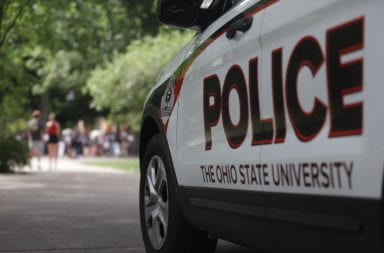
Safety tips given regarding scooter and bicycle usage include riding on roads, parking in designated areas and yielding to pedestrians. Credit: Zachary Rilley | Photo Editor
Electric scooters, easily identifiable by their bright colors and high speeds, have become a fixture of campus life. However, Ohio State expressed its safety concerns with scooters in a universitywide email Sept. 11.
According to the email, Ohio State reminded students to take safety measures while riding electric scooters. These measures included riding them on the road, keeping off sidewalks, parking in designated areas in order to not block pathways, wearing a helmet and yielding to pedestrians.
University spokesperson Dan Hedman said in an email in order for everyone to remain safe on campus, individuals should be responsible when they travel no matter what mode of transportation they use.
“Ohio State believes in a multimodal transit system and asks everyone to travel responsibly, look out for their fellow Buckeyes and share the road,” Hedman said.
Hedman said the university also has measures to ensure people remain safe when there is increased foot traffic on and near campus.
“On football Saturdays, scooters do not operate in areas near the stadium,” Hedman said. “This is a safety measure with increased foot traffic.”
Hedman said he would also like to remind students the Oval is always a walk zone, and scooters and bikes should always be walked, not ridden, across the area.
The City of Columbus is also concerned about scooter safety and has plans to enforce safe scootering. Restrictions have been created to deal with the problem presented by irresponsible riders. Debbie Briner, public relations specialist for the city’s Department of Public Service, said in an email certain areas of Columbus have been geofenced, preventing scooters from being driven through the digitally fenced-off areas.
“The City of Columbus works with our e-scooter vendors to implement digital, or “geofenced” no-ride zones as a safety measure in areas with high pedestrian traffic and to help safety concerns identified by the Division of Police,” Briner said. “The scooter operators’ apps inform a device user of no-ride zones, and the devices won’t operate in them.”
Briner said these no-ride zones can either be temporary or permanent, depending on the pedestrian traffic in these areas. Long term no-rides zones near campus are currently in place along High Street in the Short North to address safety concerns, she said.
“No-ride zones may be implemented for a temporary period, such as for major events downtown like Red, White & Boom and outdoor festivals that attract large crowds with high traffic and pedestrian volumes,” Briner said.


